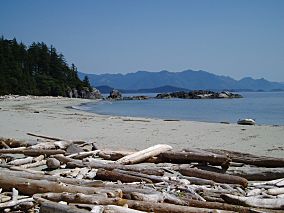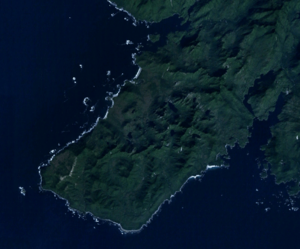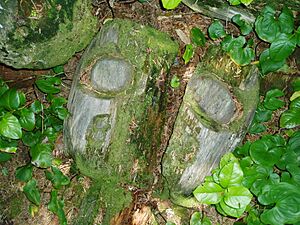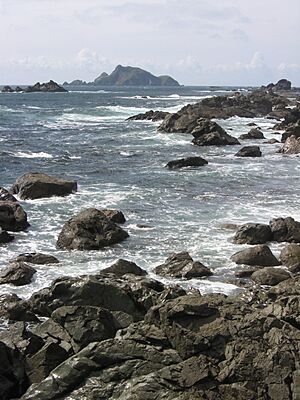Brooks Peninsula Provincial Park facts for kids
Quick facts for kids Mquqʷin/Brooks Peninsula Provincial Park |
|
|---|---|
|
IUCN Category Ib (Wilderness Area)
|
|

A deserted beach on southern coast of the Brooks Peninsula
|
|
| Location | British Columbia, Canada |
| Nearest city | Port Alice |
| Area | 51,631 ha (127,583 acres) |
| Established | December 10, 1995 |
| Governing body | BC Parks |
Mquqʷin/Brooks Peninsula Provincial Park is a special provincial park found on the west coast of Vancouver Island in British Columbia, Canada. It's a wild and beautiful place that stretches out into the Pacific Ocean. This park protects unique landscapes, ancient forests, and important cultural sites.
Contents
Park History: How it Became a Park
This amazing area became a park in stages. It started as a recreation area in 1986. Then, in 1995, it was made into a Class 'A' Provincial Park. This means it's a very important area to protect.
A large section, called the Brooks-Nasparti area, was added to the park in 1995. This made the park much bigger. The park's name has also changed over time. In 2009, it became Brooks Peninsula Provincial Park (also known as Mquqʷin). In 2018, its name was updated to Mquqʷin/Brooks Peninsula Provincial Park. This was done with guidance from the Che:k'tles7et'h' people, honoring their traditional name for the area.
Park Geography: Exploring the Land
The park covers a huge area of 51,631 hectares (about 127,583 acres). It's located about 20 kilometres (12 miles) southwest of Port Alice, British Columbia. Getting to the park is an adventure itself, as you can only reach it by boat or float plane.
Coastline and Forests
The Brooks Peninsula sticks out about 20 kilometres (12 miles) into the Pacific Ocean. It has a very rough and diverse coastline. You can find long, narrow fjords and beautiful sandy beaches here. The land further inside the park is rarely explored. It's covered in very thick forests, mostly made up of ancient trees.
Mountains and Unique Plants
The highest point in the park is a part of Snowsaddle Mountain, reaching 1,143 metres (3,750 feet) high. Other mountains in the park, known as the Refugium Range, include Klaskish (963m), Nunatak (930m), and Doom (787m).
These mountains are special because they were above the glaciers during the last ice age. This means they were not covered by ice. Because of this, they became a refugium, a place where unique plants survived. These plants are not found in many other places.
Conservation: Protecting a Special Place
The Brooks Peninsula is a very unique geological area. It was not affected by the last ice age, which makes its geology different from the rest of Vancouver Island. This means many rare plant communities grow here. It offers amazing chances for scientists to study nature.
This wild area has a long, untouched ocean coastline and calm, sheltered inlets. It also has rugged mountains and clean river mouths (estuaries). These estuaries are important for many waterfowl and fish. The park also protects a high number of different living things (biodiversity) found in its old-growth forests. The added Brooks-Nasparti area includes entire river systems and coastal slopes, further protecting this valuable wilderness.
The park helps protect the peninsula's natural wilderness. This includes the Refugium Range of the Vancouver Island Ranges. It also protects the Coastal Western Hemlock forest, which is a special type of forest found in this climate zone.
Cultural Heritage: First Nations History
The park is located on the traditional lands of the Kyuquot/Cheklesahht and Quatsino First Nations. These are the Indigenous peoples who have lived here for thousands of years. Battle Bay, in the southern part of the park, is especially important for First Nations history. Many battles were fought here to keep control of this rich area.
Please note that First Nations reserves next to the park are not for public recreation. Visitors should contact the Kyuquot/Cheklesahht First Nation band office in Kyuquot before exploring the Brooks Peninsula. This helps show respect for their land and culture.
Recreation: What to Do in the Park
Brooks Peninsula is not visited very often because it's so remote. However, its surrounding waters are excellent for kayaking and canoeing. The park is completely undeveloped. This means there are no marked trails or facilities like washrooms or campsites. Sometimes, ocean debris is placed at spots that are known as trail beginnings.
Camping is allowed anywhere in the park. But remember, it can be hard to camp here because it's so far away, difficult to reach, and has no services.
Nearby Solander Island is an Ecological Reserve. This means access to the island is not allowed to protect its sensitive environment.
Gallery
See also
- List of British Columbia Provincial Parks
- List of Canadian provincial parks






